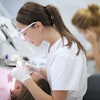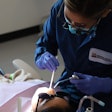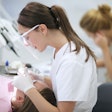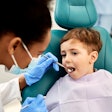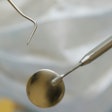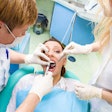
An extensive review of the literature documenting care provided by dental therapists worldwide indicates that these caregivers offer safe, effective dental care, especially for children, according to a new report released today by the W.K. Kellogg Foundation.
The 400-page report, "A Review of the Global Literature on Dental Therapists: In the Context of the Movement to Add Dental Therapists to the Oral Health Workforce in the United States," provides a literature-based review of the history and practice of dental therapists in 54 countries. It was authored by 17 contributors, all academics or public health officials who are knowledgeable about dental workforce issues in their respective countries, according to Kellogg.
After reviewing more than 1,100 reports about dental therapists and their work in various countries, the authors found no evidence to indicate that the public perspective of dental therapists in any country was anything but positive.
The report took almost a year to compile and write, according to principal author David Nash, DMD, EdD, professor of pediatric dentistry at the University of Kentucky College of Dentistry.
"It is a unique document," he told DrBicuspid.com. "We looked at 1,100 documents that had some degree of relevance to dental therapists in practice. Some people have suggested that we need more research involving dental therapists, but we wanted to bring to their attention that there is already very much documentation from all around the world."
The report documents evidence that dental therapists can effectively expand access to dental care, especially for children, and that the care they provide is technically competent, safe, and effective. It also showed that the public values the role of dental therapists and that there is strong patient and parental support for their work.
"There is no question that dental therapists provide care for children that is high quality and safe. None of the 1,100 documents reviewed found any evidence of compromises to children's safety or quality of care," said Dr. Nash. "Given these findings, the profession of dentistry should support adding dental therapists to the oral health care team."
Improving pediatric care
The report comes at a time when the U.S. is struggling to expand access to dental care, especially for children. Close to 50 million people in the U.S. live in areas where they cannot gain easy access to a dentist, according to Kellogg.
In 2014, as part of the Affordable Care Act, an additional 5.3 million children will be entitled to dental coverage under Medicaid, according to the Pew Charitable Trusts. Yet few dentists treat Medicaid patients now, and there have been wide reports of children on Medicaid waiting months to get care, Kellogg noted.
"Barriers to dental care have created significant oral health inequities for children in this country," said Sterling Speirn, president and CEO of the W.K. Kellogg Foundation. "And this greatly impacts their overall health and well-being. We need to strongly consider expanding the number of dental professionals who can offer routine, preventive care to children in their own communities."
“Despite our best efforts, dental disease is still widespread among children.”
— David Nash, DMD, EdD, University of Kentucky College of Dentistry
Historically, the focus of dental therapists has been on the prevention and treatment of dental disease in children. They typically provide routine care that includes cleanings, filling cavities, preventive care and extractions of children's teeth. In many countries, such as New Zealand and Australia, dental therapists provide their services through the school system, according to the report. However, while the scope of practice has typically been restricted to children, a few countries are beginning to permit dental therapists to treat adults, as well.
Countries using dental therapists have been effective in improving access and the care provided to children, the report noted. In New Zealand, 96% of school-age children and 49% of preschool children are enrolled in the school dental service and cared for by dental therapists. In Malaysia, 96% of elementary school children and 67% of secondary school children are enrolled in the school dental service staffed by dental therapists. And in Hong Kong, 95% of children have access to dental care in school clinics.
"Despite our best efforts, dental disease is still widespread among children [in the U.S.], and it is very expensive," Dr. Nash said. Dental therapists could be the key to helping the U.S. address oral healthcare disparities, especially among younger patients, he added.
"Today, general dentists in the U.S. are graduating from school with fairly limited knowledge of how to treat children," he said. "As a dental educator, I can say that we are not doing as effective a job of teaching our dentists how to care for children as we once did. When the dental community reflects on this long enough, they will come to understand that dental therapists practicing in schools, offices, and elsewhere treating children could be a real way for our profession to address the needs of our children."
The survey also indicated that dental-therapist-led school services are cost-effective. School dental programs in New Zealand and Australia cost less than private fee-for-service systems. The average cost of school-based dental care in New Zealand in 2010-11 was $99 per child, which included all preventive care and treatment of cavities. In the private sector, the cost would be similar for just one examination visit, and a simple restoration would cost an additional $99.
"Our profession is noble enough that we want to deal with this issue in a substantive way, and to do that we will have to change the system," Dr. Nash said. "We need to look for best practices, and when looking internationally at care for kids, the best practice is school-based dental therapists. That is what our review of the literature demonstrated."
Opposing views
However, both the ADA and the American Academy of Pediatric Dentistry (AAPD) took issue with several aspects of the Kellogg report.
"The AAPD is strongly committed to improving the oral health status of America's children through a variety of advocacy, service, and public education initiatives," stated Rhea Haugseth, DMD, president of the AAPD, in a prepared statement.
"Therefore, the AAPD wants to ensure that the best interests of children come first and foremost in any strategies that address access to oral healthcare.Although we are pleased that a compendium of literature related to the use of nondentist providers that offer dental services throughout the world has been compiled, we remain unconvinced of the potential effectiveness of this type of model in the U.S. To my knowledge, none of the reports assessed the effect of these providers on the long-term oral health of high-risk populations."
The Kellogg report fails to take into account the amount of resources needed to support dental therapist programs and the potential impact of these resources if directed toward improving access to a true dental home, she added.
The ADA took an even stronger stand.
"The report released today by the W.K. Kellogg Foundation is a comprehensive compilation of publications and anecdotes about the prevalence and use of midlevel providers, commonly referred to as dental therapists, worldwide," the ADA said in a prepared statement. "It does not, however, rise to the level of a systematic literature review, nor does it adequately address some of the key indicators of whether and to what extent the use of therapists improves public oral health."
Rather than an evidence-based report, it appears to be "a 460-page advocacy document intended to support a predetermined conclusion," the ADA wrote. In addition, according to the ADA:
The monograph describes current utilization of dental therapists and concludes that they improve access to care and are effective in providing oral healthcare within their scope of practice. A more significant, long-term indicator would have been to assess the impact of dental therapists on the overall oral health status of the population.
This monograph is similar to other reports that address access and cost. However, these are surrogate criteria for direct outcomes of reduced disease burden and cost-effectiveness, defined as the cost of treatment and the impact it has on oral health. Not measuring these direct outcomes diminishes the manuscript's conclusions and compromises its value.
The report notes the great diversity in training, scope of practice, and supervision of dental therapists worldwide. But it fails to examine why there seems to be no consensus on these factors among the many countries it cites. It also fails to account for what amounts to a constant shifting of these factors within some of the very countries it cites as proof of dental therapists' efficacy.
While repeatedly referring to 54 countries that employ therapists in some capacity, the authors concede that "no documents could be located" for more than half (28) of those countries, and that they instead relied on "verbal reports from knowledgeable persons -- that dental therapists practice in 16 of these countries."
"To be sure, workforce innovations are one component of breaking down the barriers that impede too many Americans from attaining good oral health," the ADA stated. "But no matter who is providing care, no amount of adjusting workforce scope of practice or supervision will effect significant, lasting change without the nation addressing other, greater barriers to oral health" -- notably, the Medicaid system.
"The nation will never drill, fill, and extract its way out of what amounts to a public health crisis among some populations," the association stated. "What is required is a fundamental shift in oral health from a model of surgical intervention to one of disease prevention because virtually all dental disease is preventable."



